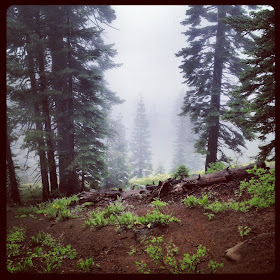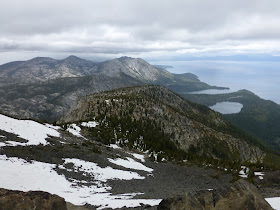When I first signed up for the Grand Slam of Ultrarunning
(four of the original 100 milers in one summer – Western States, Vermont,
Leadville and Wasatch Front), I never expected it to be easy. That’s kind of
the point, to challenge my mind and body in a new way. However, I think I was
getting caught up in the fun side of things and not appreciating that even the
race with the least climbing of the four, Vermont, is very tough just three
weeks after running Western States.
If there’s a theme so far in this year’s summer for me, it’s
heat. Western States was the second hottest in its 40-year history and Vermont
in summer is guaranteed to be humid and probably boiling too. The North-East was
hit by a heat wave combined with huge amounts of rain so I mentally prepared
myself for dealing with that and applying the lessons from Western States on
keeping cool.
Just to add to the mix I decided to pace a friend, Glen
Redpath, at Badwater 135, which finished just four days before Vermont and
screwed up sleep and rest in the final week. However, it was very enjoyable and
worthwhile to see Glen wrestle through 125 degree Fahrenheit highs and close
well enough to finish under 30 hours, in 29h58m for 12th place. It’s
the third year I’ve paced through Death Valley and each has been rewarding as
well as very enlightening about how to deal with extreme heat and lack of
shade. If I was to run that race in the future I know I’d be much better
prepared but pacing is a lot more pleasurable, and at a fraction of the cost.
Just to make the rest of us feel like wimps, Keith Straw is running the Grand
Slam plus Badwater for the second time…he ran sub 24 hours at both Western and
Vermont!
 |
| Badlands near Badwater |
 |
| 10am start wave at Badwater 135 |
 |
| Glen being paced by his brother, Mike Redpath |
 |
| Glen at the dawn of day two of Badwater |
 |
| Long road to Mt Whitney |
 |
| Glen with the crew he may have wished he had |
I took a red-eye to Boston from Badwater on Wednesday night
pre-Vermont then arrived at the race HQ, a field with no phone reception and
basically no nearby hotels, on Friday. Spirits were high as everybody
contemplated the weather and how that might impact things. With many people
camping I opted to sleep in the small rental car, which wasn’t ideal. When a
seriously impressive and dramatic thunderstorm erupted at 11pm, I was happy I’d
avoided my tiny, non-waterproof tent. Even though I had to be up for the 4am
start I couldn’t help watching the storm for a while as it lit up the sky and
helped to bring the humidity and temperature down briefly.
That storm helped to make the weather much more manageable
for the first 40-50 miles of the race although it warmed up and both Nick Clark
and Nick Pedatella told me afterwards that they really felt the heat. The
weather was the least of my worries since I’ve never had so many things go
wrong in a race. Although I’d done some test runs, even with speed, I hadn’t
run anything remotely long since Western States and therefore didn’t know how
much fatigue I would have to deal with on race day. The answer was lots.
Eating too much at the pre-race dinner meant I had three
emergency toilet stops in the first 20 miles and kept dropping off the lead
pack each time then gradually reeling them in. The fairly gentle hills and
mainly fire-road trails felt reasonably good, even in the first hour which was
fully dark. We had plenty of chat and banter between our small group, which
included Jason Lantz (the eventual winner), Chad Ricklefs (leader up to mile
98.5) and Nick Clark. The race within the race was between Nick and myself since
we were both comfortably under the Grand Slam record split from Western States
with a relatively narrow margin of 36 minutes between us. So when Nick
disappeared in the distance and I dropped to around eighth after 25-30 miles,
it wasn’t a good sign. Getting lost for a few minutes at mile 40-something
didn’t help either, but the mistake was quickly corrected.
The relatively easy and non-technical terrain is deceptive
in that much of it (but not all) is fast and gentle in itself but it
cumulatively adds up enough that tired legs soon become nearly useless. 100
milers tend to be large patches of feeling good mixed in with a few bad spots
and a grind to the finish. This one was almost reversed for me, with long
sections of feeling completely fatigued and sore with the occasional fast
couple of miles. I had periods of dizziness, light-headedness and sickness with
the best sections merely hurting, even early on. Throughout it all I had to
fight off the demons of negative voices in my head and stop myself from thinking
about anything that wasn’t going well, instead reminding myself I was moving
forwards and that nothing was serious enough to warrant giving up or not
pushing on. As per Bryon Powell’s, it was all about ‘Relentless Forward
Progress.’
It wasn’t fun for me and I wasn’t able to enjoy the course
like I’d hoped to. At mile 70 my pacer, Jordan Fields, joined me and I felt sorry for him for having
to go so slowly since he’s a top class cross-country skier and 12-15 minute
miles were like going backwards. Miles 70-80 were so about my slowest and I
expected that the final 20 would be equally poor. Luckily the pain and
dizziness faded to a more standard dull ultra ache and that meant faster
running was more feasible. I was in fifth and Nick was 13-14 minutes ahead so
my aim was to minimize that gap and maybe catch him if he hit a particularly
bad spell.
In honesty I don’t want to remember much of the day because
the best memory was crossing the finish line. I’m very happy I didn’t give up
and managed the worst parts of the day well enough to keep moving at a fair
pace throughout, so I’ve got my grinder hat on and am ready to dig in for the
last two races of the Slam. DNF is not an option, especially after forcing
myself through two tough days already.
I closed slightly on Nick in the final miles and overtook last year’s winner (who only missed the course record by a minute in 2012), Brian Rusiecki, to climb to fourth. He passed me like I was petrified at mile 50 but was suffering at the end and didn’t really try to race me. 15h57m was my eventual time, three minutes behind Nick and with splits that weren’t too uneven – around 7h30m for the first half and 8h27m for the remainder. Here’s the Strava data. Both Nick and myself clocked the altitude gain at 15,300ft, a little more than advertized (in contrast, my watch showed WS as 500ft of ascent less than advertised). Full results here.
The race had several differences to what I’m used to on the West Coast, including having multiple distances of horse races at the same time as the run, although they didn’t really impact runners under about 18 hours in the 100 mile run. Aid stations were plentiful as there were 30, but many were unmanned with just water, Coke and Gatorade in huge containers that were awkward to fill water bottles from. No gels at any aid stations also made it harder to fuel as I usually have 50+ in this type of race and was limited to what I brought with me. I’d guess this is a result of littering on the private property the race goes through in the past.
I closed slightly on Nick in the final miles and overtook last year’s winner (who only missed the course record by a minute in 2012), Brian Rusiecki, to climb to fourth. He passed me like I was petrified at mile 50 but was suffering at the end and didn’t really try to race me. 15h57m was my eventual time, three minutes behind Nick and with splits that weren’t too uneven – around 7h30m for the first half and 8h27m for the remainder. Here’s the Strava data. Both Nick and myself clocked the altitude gain at 15,300ft, a little more than advertized (in contrast, my watch showed WS as 500ft of ascent less than advertised). Full results here.
The race had several differences to what I’m used to on the West Coast, including having multiple distances of horse races at the same time as the run, although they didn’t really impact runners under about 18 hours in the 100 mile run. Aid stations were plentiful as there were 30, but many were unmanned with just water, Coke and Gatorade in huge containers that were awkward to fill water bottles from. No gels at any aid stations also made it harder to fuel as I usually have 50+ in this type of race and was limited to what I brought with me. I’d guess this is a result of littering on the private property the race goes through in the past.
It’s an historic and great race which I feel I didn’t do
justice too, except through the fact I didn’t give up. On second thoughts that’s
probably the most defining aspect of a 100-miler, so the other bits I care
about personally (like times and positions) are less relevant. The scenery very
much reminded me of the UK and of many trail races I’ve run there, including
the muddy woodland paths.
Leadville is four weeks away so the extra week of recovery
should help, plus I’ll be staying in Colorado for two weeks pre-race to get
some easy altitude acclimatization in. From speaking to past Slammers things
usually feel better by Leadville so I really hope that’s true. Paul Terranova
was able to run the Hawaii Ironman after his 80-hour slam last year and did so
pretty fast (for mere mortals, not by his standards).
Number of starters – 31 (plus Nick Clark unofficially)
Number of runners left after Western States – 28 (plus Nick)
Number of runners left after Vermont – 26 (plus Nick)
Neil Gorman’s 2010 total time to the end of Vermont when setting the GS record: 34h47m
Scott Jurek’s 2004 total time to the end of Vermont in his GS: 32h17m
Nick Clark’s total GS time to date: 32h51m
My total GS time to date: 32h18m
Gear used at Vermont:
Scott Kinabalu T2 trail shoes
UltrAspire handhelds
Julbo Dust shades
Clif Bar Shot gels (not nearly as many as I needed)
Drymax Max Protection Trail socks
Number of runners left after Western States – 28 (plus Nick)
Number of runners left after Vermont – 26 (plus Nick)
Neil Gorman’s 2010 total time to the end of Vermont when setting the GS record: 34h47m
Scott Jurek’s 2004 total time to the end of Vermont in his GS: 32h17m
Nick Clark’s total GS time to date: 32h51m
My total GS time to date: 32h18m
Gear used at Vermont:
Scott Kinabalu T2 trail shoes
UltrAspire handhelds
Julbo Dust shades
Clif Bar Shot gels (not nearly as many as I needed)
Drymax Max Protection Trail socks




























